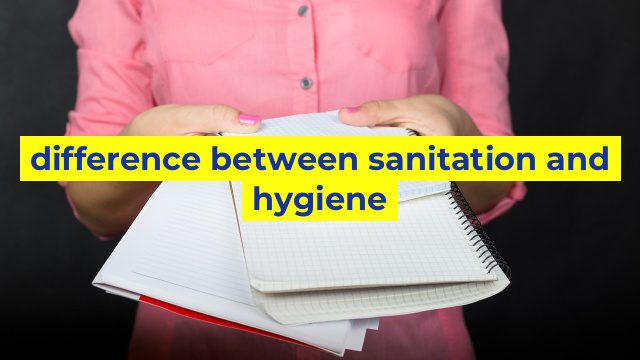The Difference Between Sanitation and Hygiene
When it comes to maintaining a clean and healthy environment, two terms are often used interchangeably: sanitation and hygiene. While both are essential for preventing the spread of diseases and promoting well-being, they are not the same thing.
Sanitation
Sanitation refers to the process of removing or reducing harmful agents from the environment. This includes the disposal of waste and the treatment of water and sewage. Sanitation is crucial for preventing the spread of infectious diseases such as cholera, typhoid fever, and dysentery.
In a broader sense, sanitation also includes measures to ensure food safety, such as proper storage and handling of food to prevent contamination. Good sanitation practices reduce the risk of illness by limiting exposure to germs and toxins in the environment.
Hygiene
Hygiene, on the other hand, refers to the practices and behaviors that prevent the spread of infections in humans. This includes personal hygiene, such as washing hands regularly, taking showers, and brushing teeth. Hygiene also includes environmental hygiene, such as cleaning and disinfecting surfaces, avoiding contact with sick people, and promoting healthy behaviors like covering coughs and sneezes.
Practicing good hygiene is an essential part of preventing the spread of diseases, especially those that are transmitted through direct contact with people or contaminated surfaces.
The Importance of Sanitation and Hygiene
Both sanitation and hygiene are crucial for maintaining a safe and healthy environment. Without proper sanitation practices, waste and sewage can accumulate and spread harmful bacteria and parasites, leading to outbreaks of disease. Without good hygiene practices, individuals can spread infections to others, and the risk of illness increases significantly.
In conclusion, sanitation and hygiene are two different but equally essential concepts for keeping ourselves and our environment healthy. Practicing good hygiene and sanitation habits can help prevent the spread of infectious diseases and promote overall well-being. So, always remember to wash your hands, clean your surroundings, and dispose of waste properly for a healthier tomorrow.
Table difference between sanitation and hygiene
| Sanitation | Hygiene |
|---|---|
| Sanitation refers to the process of maintaining cleanliness and hygiene in the surrounding environment. | Hygiene refers to the set of practices that are aimed at maintaining personal cleanliness and preventing the spread of diseases. |
| Sanitation deals with the removal of waste materials and the provision of clean water supply and properly functioning sewage systems. | Hygiene deals with personal cleanliness practices such as hand washing, bathing, brushing teeth, and keeping the hair clean. |
| Sanitation is important to prevent the spread of diseases caused by unsanitary conditions such as poor waste management, dirty water, and poor air quality. | Hygiene is important to prevent the spread of diseases caused by poor personal hygiene habits such as not washing hands after using the bathroom or before eating, and not covering the mouth and nose when coughing or sneezing. |
| Examples of sanitation practices include proper disposal of waste materials, regular cleaning of public and shared spaces, and provision of clean water and electricity. | Examples of hygiene practices include washing hands with soap and water, taking regular showers, practicing safe sex, and wearing clean clothes. |

